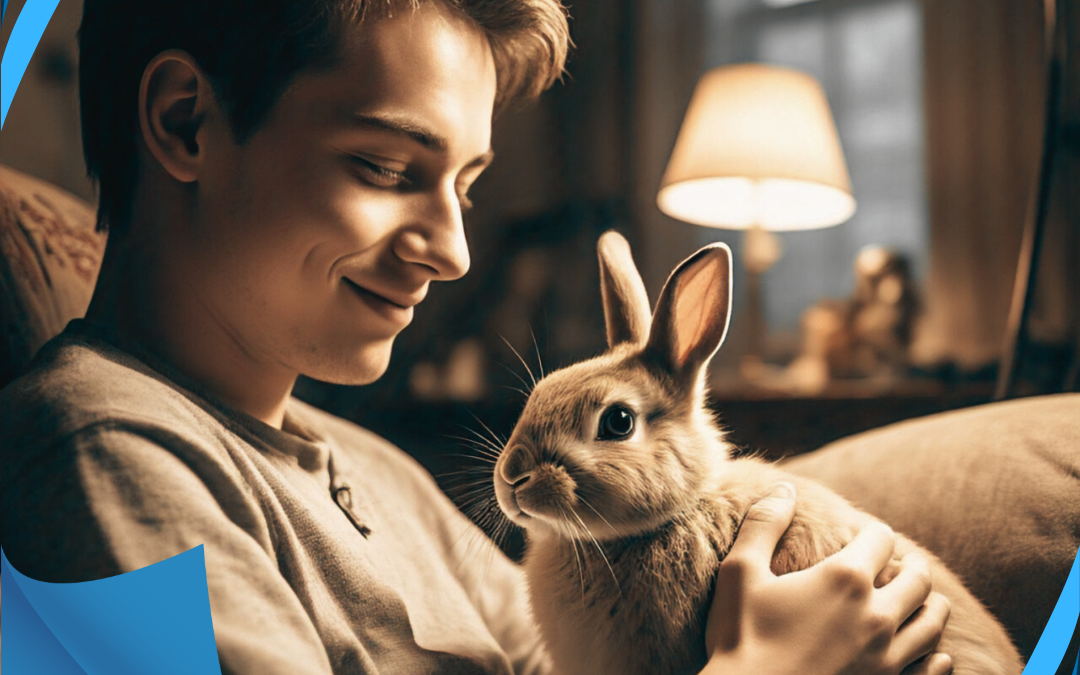Pet rabbits are cute and cuddly, but they can get fleas just like cats and dogs. Rabbits can catch fleas from playing outside or from other pets in the home. These tiny parasites can cause itching, discomfort, and even health problems for your furry friend.

Keeping your rabbit flea-free is important for their well-being. Regular flea prevention helps protect your pet and makes sure they stay happy and healthy. There are safe and effective ways to prevent and treat fleas in rabbits.
Key Takeaways
- Rabbits can get fleas from the outdoors or other pets in the home
- Regular flea prevention is key to keeping pet rabbits healthy and comfortable
- Safe flea treatments for rabbits are available through veterinarians
Understanding Rabbit Fleas

Rabbit fleas are tiny parasites that can cause big problems for pet bunnies. These pesky bugs feed on blood and can make rabbits very itchy and uncomfortable.
What Are Fleas?
Fleas are small insects that live on animals. They’re about the size of a pinhead and can jump really far. Rabbit fleas have flat bodies and strong legs for jumping.
These bugs bite rabbits to drink their blood. This can make bunnies scratch a lot. Sometimes, you might see tiny black specks on your rabbit’s skin or fur. This is called “flea dirt” and it’s actually flea poop.
Fleas can cause more than just itching. They might make rabbits lose fur or get skin infections. In some cases, fleas can even make rabbits very sick.
The Life Cycle of Fleas
Fleas go through four stages in their life: egg, larva, pupa, and adult. The whole cycle can take as little as 2-4 weeks.
Adult fleas lay tiny white eggs on rabbits. These eggs fall off into the environment. They hatch into larvae, which look like small worms. Larvae eat things like dead skin and flea poop.
Next, larvae spin cocoons and become pupae. After a few days, adult fleas come out. They jump onto rabbits to feed and start the cycle again.
Fleas can live in carpets, bedding, and grass. This means it’s important to clean these areas to get rid of all flea stages.
Recognizing Flea Infestation

Fleas can be a big problem for pet rabbits. Knowing the signs of fleas and their effects is key to keeping your bunny healthy and comfy.
Signs of Fleas on Rabbits
Rabbits can get fleas just like cats and dogs. Watch for these clues:
• Scratching or biting at their fur more than usual
• Red, irritated skin
• Hair loss, especially around the neck and back
• Tiny dark specks in the fur (flea dirt)
• Small, fast-moving bugs in the coat
To check for fleas, use a fine-toothed comb on your rabbit’s fur. Look for tiny dark specks that turn red when wet – that’s flea poop. You might also see the fleas themselves jumping around.
Complications of Flea Infestations
Fleas are more than just itchy pests. They can cause serious health issues for rabbits:
• Anemia: Fleas drink blood, and lots of them can make a rabbit lose too much.
• Skin infections: All that scratching can lead to sores and infections.
• Tapeworms: Rabbits can get tapeworms by eating fleas while grooming.
• Weakness and lethargy: Flea bites can make rabbits feel tired and unwell.
In rare cases, fleas can spread diseases like myxomatosis. This is why it’s so important to treat flea problems quickly and keep your rabbit protected.
Preventing Fleas in Pet Rabbits

Keeping pet rabbits flea-free involves a mix of careful cleaning and regular grooming. These steps help create an unwelcoming setting for fleas and catch any issues early.
Environmental Measures
Indoor rabbits need a clean living space to stay flea-free. Vacuum floors and furniture often, paying extra attention to corners and cracks where flea eggs might hide.
Wash your rabbit’s bedding weekly in hot water. This kills any fleas or eggs that may be present.
For outdoor rabbits, keep their hutch clean and dry. Remove wet bedding right away to stop fleas from breeding.
Treat your yard if you have outdoor pets. Ask a vet about safe, rabbit-friendly yard treatments.
Grooming and Hygiene
Brush your rabbit’s fur daily. This helps spot fleas early and removes any that might be there.
Use a flea comb to check for fleas or flea dirt. Pay close attention to your rabbit’s neck, back, and tail areas.
Bathe your rabbit only when needed, as too much bathing can dry out their skin. If you do bathe them, use a gentle, rabbit-safe shampoo.
Check your rabbit after they’ve been outside. Brush their fur to remove any fleas they might have picked up.
Ask your vet about safe flea prevention products made just for rabbits. Never use products meant for dogs or cats on your rabbit.
Treating Fleas on Rabbits

Fleas can be uncomfortable and dangerous for pet rabbits. Getting rid of these pesky parasites requires using safe, effective treatments and following proper application methods. It’s important to know when professional help is needed.
Safe Flea Treatment Options
Several flea treatments are safe for rabbits. Topical medications like Revolution (selamectin) work well. Flea combs help remove adult fleas and eggs from fur. Some vets may recommend oral medications in certain cases.
Avoid using dog or cat flea products on rabbits. Many contain ingredients that are toxic to bunnies. Never use flea collars, powders, or sprays meant for other pets.
Always check with a rabbit-savvy vet before trying any new flea treatment. They can recommend the safest, most effective options for your bunny’s specific needs.
Applying Topical Treatments
When using topical flea treatments, follow the instructions carefully. Part the fur at the back of the neck and apply the medication directly to the skin. This spot is hard for rabbits to reach, so they won’t lick it off.
Wear gloves to protect your skin. Make sure to use the correct dosage for your rabbit’s weight. Too little won’t work, while too much can be harmful.
After applying, keep your rabbit in a small, confined area for a bit. This lets the medication dry and spread properly before the bunny grooms itself.
When to Consult a Veterinarian
Call your vet if you notice signs of a severe flea infestation. These include extreme itching, hair loss, or small black specks (flea dirt) in the fur. Rabbits with lots of fleas can become weak or anemic.
Get help right away if your bunny seems lethargic, loses appetite, or has pale gums. These could be signs of flea-related illness.
Some rabbits may need prescription-strength treatments or additional care. A vet can provide the best plan to get rid of fleas and keep your furry friend healthy.
Other Skin Parasites

Rabbits can get more than just fleas. Some tiny bugs can cause big problems for bunnies. Let’s look at other creepy crawlies that might bother your pet rabbit.
Mites and Lice in Rabbits
Mites and lice are common skin parasites in rabbits. Mites are super small and can cause itching and hair loss. Ear mites live in rabbit ears and make them scratch a lot.
Lice stick to rabbit fur and lay eggs. They can make bunnies very itchy too. Both mites and lice can spread between rabbits easily.
Signs of these pests include:
- Scratching more than usual
- Losing fur
- Red, scaly skin
- Crusty ears (for ear mites)
Managing Non-Flea Parasites
Keeping rabbits clean and checking their skin often helps catch problems early. Special spot-on treatments can get rid of mites and lice. But be careful! Some flea products for cats and dogs can hurt rabbits.
Never use flea powder on rabbits. It can be dangerous for them. Instead, ask a vet for safe options. They might suggest:
- Ivermectin drops
- Revolution (selamectin)
- Advantage (imidacloprid)
Clean your rabbit’s home really well if they have parasites. This stops the bugs from coming back. Remember, healthy rabbits are less likely to get skin parasites.
New Rabbit Care

Getting a new rabbit is exciting. Taking some key steps when bringing your bunny home can help them settle in and stay healthy. Checking for fleas right away is important too.
Introducing a New Rabbit to Your Home
Set up a cozy space for your new rabbit before they arrive. Give them a safe enclosure with hiding spots, toys, food, and water. Let them explore at their own pace. Speak softly and move slowly around them at first.
Rabbits need time to adjust to new surroundings. Don’t handle them too much in the first few days. Gradually increase interaction as they get more comfortable.
Make sure their area is rabbit-proofed to prevent chewing on wires or other hazards. Introduce fresh veggies and hay slowly to avoid tummy troubles.
Flea Checks for New Arrivals
Check your new rabbit for fleas right away. Use a flea comb to look through their fur, especially around the ears and base of the tail. Tiny black specks could be flea dirt.
If you spot fleas, talk to your vet about safe treatments. Many flea products for dogs and cats are not safe for rabbits. Never use flea powders or over-the-counter flea drops without checking with a vet first.
Clean your rabbit’s bedding and living area thoroughly. Vacuum carpets and upholstery to remove any fleas or eggs. Regular flea checks can catch problems early and keep your new bunny happy and healthy.
Frequently Asked Questions
Pet rabbit owners often have questions about flea prevention and treatment. Here are some common concerns and helpful tips to keep bunnies flea-free and healthy.
How can you naturally remove fleas from your rabbit?
Natural flea removal methods for rabbits include regular grooming with a flea comb. This helps catch fleas and their eggs. Vacuuming the rabbit’s living area often can also help remove fleas.
Another option is to use food-grade diatomaceous earth. Sprinkle it lightly on the rabbit’s fur, avoiding the face. This natural powder can help dry out and kill fleas.
What is the most effective flea treatment for a domestic rabbit?
The most effective flea treatments for rabbits are those prescribed by a vet. These are specially made for rabbits and are safe to use.
It’s important to never use dog or cat flea treatments on rabbits. These can be very dangerous and even deadly for bunnies.
Is it possible for rabbits to contract fleas from other household pets?
Yes, rabbits can get fleas from other pets in the house. Dogs and cats that go outside can bring fleas in, which may then jump to the rabbit.
If one pet in the house has fleas, it’s best to treat all pets at the same time. This helps stop the spread of fleas between animals.
How do you protect your rabbit from fleas and ticks?
To protect rabbits from fleas and ticks, keep their living area clean. Vacuum often and wash their bedding in hot water.
Check your rabbit’s fur regularly for signs of fleas or ticks. Use a flea comb to catch any pests early. Keep grass short in outdoor play areas to reduce tick risks.
Do pet rabbits require regular flea prevention treatments?
Not all pet rabbits need regular flea treatments. Indoor rabbits with no contact with other animals may not need them at all.
For rabbits that go outside or live with other pets, regular prevention might be a good idea. Ask a vet about the best plan for your bunny.
What steps can be taken to prevent parasites in pet rabbits?
To prevent parasites, keep your rabbit’s home clean and dry. Change bedding often and clean litter boxes daily.
Feed your rabbit a healthy diet to boost their immune system. Regular vet check-ups can catch parasite problems early. Ask your vet about safe parasite prevention methods for rabbits.



